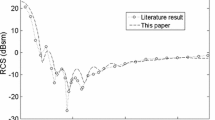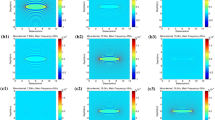Abstract
The asymptotic waveform evaluation (AWE) technique is a rational function approximation method in computational mathematics, which is used in many applications in computational electromagnetics. In this paper, the performance of the AWE technique in conjunction with hybrid finite element/boundary integral (FE/BI) method is firstly investigated. The formulation of the AWE applied in hybrid FE/BI method is given in detail. The characteristic implementation of the application of the AWE to the hybrid FE/BI method is discussed. Numerical results demonstrate that the AWE technique can greatly speed up the hybrid FE/BI method to acquire wide-band and wide-angle backscatter radar-cross-section (RCS) by complex targets.
Similar content being viewed by others
References
Yuan X. Three-dimensional electromagnetic scattering from inhomogeneous objects by the hybrid moment and finite element method. IEEE Trans Microwave Theory Tech, 1990, MTT-38: 1053–1058
Sheng X Q, Song J M, Lu C C, et al. On the formulation of hybrid finite-element and boundary-integral method for 3D scattering. IEEE Trans Antennas Propagat, 1998, 46(3): 303–311
Xu X Y, Li J K, Xu G L. Theory of Pade Approximation (in Chinese). Shanghai: Science and Technology Press, 1990
Pillage L T, Rohrer R A. Asymptotic waveform evaluation for timing analysis. IEEE Trans Comput Aid Design, 1990, 9: 352–366
Polstyanko S V, Dyczij-Edlinger R, Lee J F. Fast frequency sweep technique for the efficient analysis of dielectric waveguides. IEEE Trans Microwave Theory Tech, 1997, 45: 1118–1126
Eric B J, Din-Kow S, Cendes Z J. S-domain methods for simultaneous time and frequency characterization of electromagnetic devices. IEEE Trans Microwave Theory Tech, 1998, 46(9): 1277–1290
Reddy C J, Deshpande M D, Cockrell C R, et al. Fast RCS computation over a frequency band using method of moments in conjunction with asymptotic waveform evaluation technique. IEEE Trans Antennas Propagat, 1998, 46: 1229–1233
Su Y F, Xu S J. The application of asymptotic waveform evaluation technique in fast analysis of the three-dimensional electromagnetic scattering. Acta Electronica Sinica (in Chinese), 2002, 30(6): 794–796
Xu L J, Lin B Q, Yuan N C. Application of AWE to fast calculation of wide angle RCS of 2-D conduction cylinder covered by dielectric. J Microwaves (in Chinese), 2004, 20(3): 6–9
Zhou H X, Hong W, Xu F. Pade approximation in segments applied to predict monostatic RCS pattern of a 2-D dielectric object. J Electron Inf Tech (in Chinese), 2003, 25(7): 969–974
Author information
Authors and Affiliations
Corresponding author
Additional information
Supported by the National Natural Science Foundation of China (Grant No. 60371004), and the “973” Program (Grant No. 2005CB321702)
Rights and permissions
About this article
Cite this article
Peng, Z., Sheng, X. Application of asymptotic waveform approximation technique to hybrid FE/BI method for 3D scattering. SCI CHINA SER F 50, 124–134 (2007). https://doi.org/10.1007/s11432-007-2019-9
Received:
Accepted:
Issue Date:
DOI: https://doi.org/10.1007/s11432-007-2019-9




